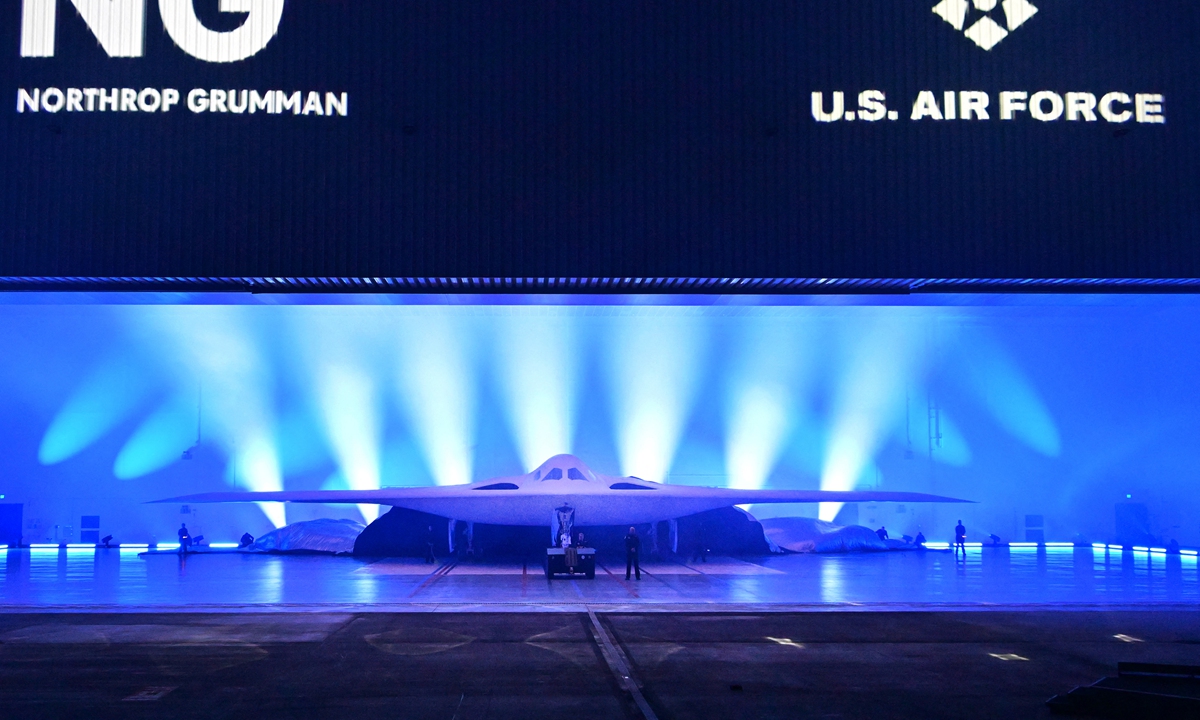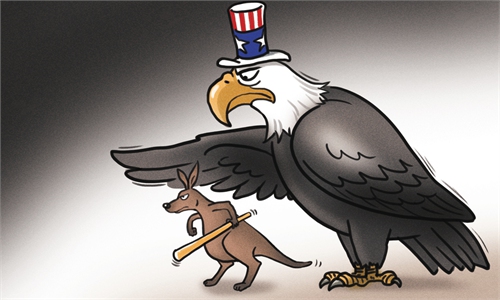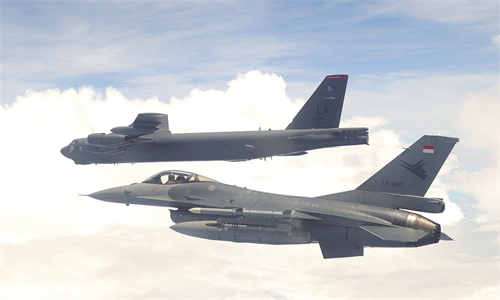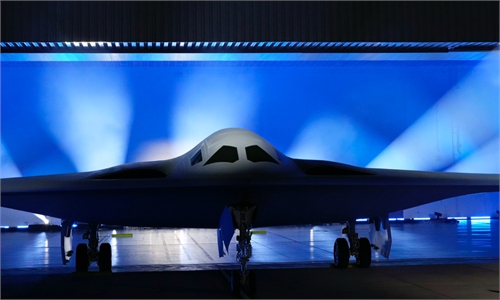If targeting Taiwan Straits, US military’s B-21 will only be a paper plane: Global Times editorial

The new B-21 Raider is unveilled during a ceremony at Northrop Grumman's Air Force Plant 42 in Palmdale, California, December 2, 2022.Photo: AFP
On Friday, the US' stealth bomber - B-21 "Raider" - was unveiled in a high-profile event. As this is the first new-generation bomber aircraft that the US has developed in more than 30 years, senior US military officers and the media outlets have carried out extremely high-profile publicity campaigns for it. US Secretary of Defense Lloyd Austin claimed that "even the most sophisticated air-defense systems will struggle to detect a B-21 in the sky." The chief executive of Northrop Grumman Corp - manufacturer of the aircraft - boasted that the world has "never seen technology like the B-21." Given that the US Secretary of the Air Force Frank Kendall has repeatedly made it clear to deploy the B-21 to "deter China," many US media have focused on the "dealing with China's threat" in their reports, saying it will force China to "rethink wars for decades to come."Normally, weapons that are considered as "assassin's mace" of major powers are kept strictly confidential, but the marketing and promotion of the B-21 is as much as that for an "internet celebrity."
However, despite under such a high-profile campaign, the real face of B-21 is still very mysterious. It is reported that the B-21 made its public appearance for a very short period of time, and the outside world can only obtain its frontal photos, and the specific technical indicators have not been disclosed. This is in sharp contrast to the B-2's debut more than three decades ago. The high-standard touting in concept and the super cautiousness in physical display are quite intriguing. That is to say, regardless of the actual technical level of the B-21, it is more like a "propaganda sample" that the US military-industrial complex needs to secure military budgets and for the military to push the so-called integrated deterrence against China.
On the one hand, B-21 is not only a profitable product of the "China threat theory" concocted by the US military-industrial complex, but also an important link in the continuation of this chain of interests. In fact, during the seven years from awarding contract to the debut of the B-21, various "China threat theories" by related personnel such as the secretary of the US Air Force emerged in an endless stream. Programs like strategic bombers are expensive from inception to production. Only by constantly exaggerating the "threats" of China's military power, and even concocting various lies about China's "nuclear expansion," can they gain more budget from the US Congress. The strategic bomber is only one part of the "trinity" nuclear deterrent reform that the US wants to implement now. A crucial intent of touting the B-21 and underlining its role to "confront China" is also to obtain funds for follow-up projects.
On the other hand, the high-profile publicity of the B-21 also has constituted the intention of the US military to take the opportunity to exaggerate the tension in the Taiwan Straits, thereby accelerating the transfer of military resources to the Asia-Pacific region and wooing the US allies. As we all know, although the US has always wanted to focus its energy on dealing with its most important strategic competitor, its plan to transfer its military power to the Asia-Pacific has been hindered for various factors. This time, the US military made use of the B-21 to talk about the Taiwan Straits again, saying that it will play a role. It just wants to take the opportunity of threatening it allies to show its "advanced capabilities" to rope in its allies. There are also reports that the B-21 is expected to be deployed in Guam and Australia after it enters service, and the US public opinion has boasted that it is the "strategic bomber to counter China."
Therefore, they have created a myth that having the B-21 will deter China. Austin declared that "this isn't just another airplane." Instead, "it is a testament to our strategy of deterrence." A US media outlet even threatened "B-21 Raiders could fly under the noses of Chinese S-400 air defense systems and sow the Taiwan Strait with Quickstrike mines, creating a major hazard for troop ships undertaking the already risky crossing."
However, it is necessary to remind, even if one is not a military professional or a scholar, it is easy to understand that the so-called deterrence is always a combination of military power and political determination. During the Chinese civil war from 1945 to 1949 between the Communist Party of China (CPC) and the Kuomintang (KMT), did the US send advanced weapons to the KMT in small numbers? During the Korean War (1950-53) as well as the Vietnam War (1954-75), how much American equipment was reduced to scrap metal on the battlefield or seized as trophies?
Many people still remember that when the Northrop Grumman B-2 Spirit, which was claimed by the Pentagon to have the capability of "global destruction," made its debut 34 years ago, the US became the first country across the globe to have a stealth bomber, which was promoted by many American public opinion as "the nightmare of the opponent."
However, over the past 30 years, advanced military equipment has not made Washington "rest easy." On the contrary, it has gone even harder in its pursuit of hegemony. The B-2 bomber has also been regarded as a "financial disaster" due to its high cost. It is against this backdrop that the B-21 bomber appeared. The designer's first request for it was that the cost should not be too high. Therefore, no matter what the Pentagon has boasted, in a sense, it is more like the B-21 is the "shrunk version" of the B-2.
Of course, what kind of weapons the US develops is its own business. But if its purpose is to threaten and intimidate China, it is doomed to be a daydreaming. No matter how much the Pentagon relies on the B-21 when it tries to intervene in the cross-Straits affairs, it will only become a paper airplane that will be gently falling down in the face of the iron wall of the PLA and the strong will of the 1.4 billion Chinese people. Not only will B-21 fail to prove "US deterrence," but it will only become the latest proof on the showcase of "source of American chaos."



